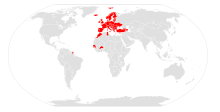- Convention on the Conservation of European Wildlife and Natural Habitats
-
The Bern Convention on the Conservation of European Wildlife and Natural Habitats 1979, also known as the Bern Convention (or Berne Convention), came into force on June 1, 1982.
It has now been signed by all member states of the Council of Europe – except San Marino and Russia – as well as by the European Union, Burkina Faso, Morocco, Tunisia and Senegal.
Algeria, Belarus, Cape Verde, the Holy See, San Marino and Russia are among non-signatories that have observer status at meetings of the committee.
Contents
Aims and objectives
The convention sets out to:
- conserve wild flora and fauna and their natural habitats;
- promote co-operation between states;
- monitor and control endangered and vulnerable species;
- assist with the provision of assistance concerning legal and scientific issues.
The convention led to the creation in 1998 of the Emerald network of Areas of Special Conservation Interest (ASCIs) throughout the territory of the parties to the convention, which operates alongside the European Union's Natura 2000 programme.
It also provides for the monitoring and control of endangered species, and the provision of assistance concerning legal and scientific issues.
Appendices
Four appendices set out particular species for protection. They are regularly updated by the Standing Committee, who are advised by a number of Expert Groups:
- strictly protected flora species – Appendix I
- strictly protected fauna species – Appendix II
- protected fauna species – Appendix III
- prohibited means and methods of killing, capture and other forms of exploitation – Appendix IV
All species of reptiles and amphibia, and most birds are included in the appendices.
In Africa
In those African countries that are, or have been invited to become, Contracting Parties, the Convention aims to curb the falling numbers and shrinking distributions of migratory species of European importance, and to press for concerted action to protect the genetic diversity of these species and their habitats and combat illegal hunting and trade. In this way, the Convention aims to preserve species of great importance for the biological diversity of both Europe and the countries in question.
See also
- Environmental agreements
- Red Data Book of the Russian Federation
External links
Categories:- Environment treaties
- Treaties concluded in 1979
- Treaties entered into force in 1982
Wikimedia Foundation. 2010.

